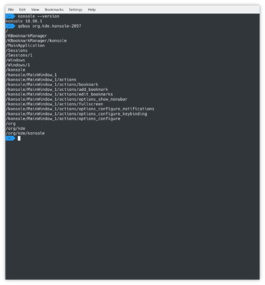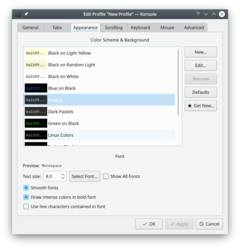Konsole
Template:I18n/Language Navigation Bar
 |
Konsole er terminalemulatoren til KDE-platformen |
Hovedpunkter
- X-Terminalemulator
- Gør det letter at bruge kommandolinjen
- Kan bruge forskelige profiler til forskellige opgaver
- Indstil grænse for tilbage-scrolling og gem indhold i fil
- Klik på links for at åbne side i brugerens standard webbrowser
- Åbn aktuel sti i brugerens filmanager
- Baggrunden kan være gennemsigtig når skrivebordseffekter er sat til
Konsole er en X-terminalemulator til KDE-platformen - en bekvem måde at bruge kommandolinjen. Konsole kan arbejde med kraftfulde kommandoskaller og har mange funktioner, som gør det lettere og mere behageligt at arbejde i kommandolinjen, herunder håndtering af profiler, tilbage-scrolling, farveskemaer og gennemsigtighed.
Konsole also provides an embedded KPart terminal which is used by apps such as Yakuake, Dolphin, and Kate, giving users a consistent and familiar interface when working in the command line.
Tutorials and Tips
Language
With Konsole you can change the language to plain English (to see bugs info for example) by command:
export LANG=C
Shortcuts
- Switch tab: SHIFT+LEFT, SHIFT+RIGHT (not like X-Chat, Firefox, Quanta, Kdevelop). Note that Quanta and Kdevelop use ALT+LEFT, ALT+RIGHT. However, SHIFT+DIRECTION has the advantage of being reachable with one hand on virtually all keyboard layouts, while ALT keys are sometimes only on the left of the keyboard (e.g. in Germany).
- New tab: SHIFT+CRTL+N.
Label your Tabs
If you regularly use a lot of tabs, you'll sometimes find it convenient to label them. Just double-click on the tab and you'll get a re-name dialogue.
Profile Management
- To add a new profile go to
- On the tab, enter the new profile name and change the icon if desired.
- If this is to be a root konsole, enter the command
/bin/su -
This command will not work on any distro that uses sudo (like Ubuntu). On such distributions use:
sudo su
or just prepend all your commands that requires superuser priviledges with sudo.
- Font size can also be changed on the tab.

- On the screen you can add or remove a star, which controls whether that profile is to be offered on the File menu.
Related Sites
Keywords
Terminal emulator, command line, CLI, shell
